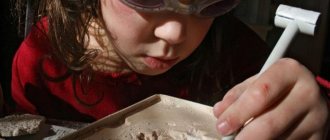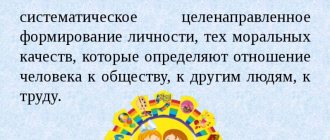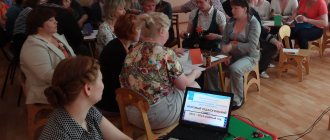“Pedagogical technologies in the cognitive development of preschool children” article
"Pedagogical technologies
in the cognitive development of preschool children"
Relevance:
The problem of developing the cognitive activity of preschool children is one of the most pressing.
Curiosity, a constant desire to observe and experiment, to seek new information about the world around us are the most important features of children's behavior. A child is born an explorer - this is his natural state. The internal desire to explore gives rise to the child’s exploratory behavior and creates the conditions for the child’s mental development to unfold as a process of self-development.
Our task, the task of teachers, is not to suppress the research and cognitive activity of children, but, on the contrary, to help its development.
The use of modern pedagogical technologies opens up new opportunities for the education and training of preschoolers, and one of the most effective, in my opinion, is -
1. Technology of children's experimentation.
It is more natural and therefore much easier for a child to comprehend new things by conducting his own research - observations, experiments, making his own judgments and conclusions based on them, than to receive knowledge obtained by someone in a ready-made form.
The child strives for independence, but he cannot understand the world without the help of an adult. At any age, the role of the teacher remains leading. Without an adult, experiments turn into aimless manipulation of objects, without conclusions and without cognitive value.
In the group room of the senior group, a center for children's experimentation called “Our Laboratory” was created, which contains natural materials: sand, water, clay, pebbles, shells, various seeds and fruits, tree bark, leaves, etc. As well as sieves and funnels of different sizes and materials, pipettes with rounded ends, plastic syringes without needles, waste material (paper of different color textures, pieces of leather, foam rubber, rubber, plastic, metal objects, cork, wire, etc.), hourglass, mechanical, etc. This form of work ensures personality-oriented interaction between an adult and a child (together, on equal terms, as partners), while creating a special atmosphere that will allow each child to realize their inquisitive and cognitive activity - information and communication technologies
Modern educational technologies include:
2. Technology of project activities
Goal: Development and enrichment of social and personal experience through the inclusion of children in the sphere of interpersonal interaction.
Teachers who actively use project technology in the upbringing and teaching of preschoolers unanimously note that life activities organized according to it in kindergarten allow them to get to know the students better and penetrate into the child’s inner world.
To ensure the cognitive activity of children in our group, the project method is widely used. It allows children to develop their cognitive abilities, teaches them to navigate the information space, and develop logical thinking. In our senior group, educational and research projects “Soap Story” and “Magnetic Miracles” were developed.
In the educational process of a preschool educational institution, project activities are in the nature of cooperation, in which children and teachers of the preschool educational institution take part, and parents and other family members are also involved. Parents can not only be sources of information, real help and support for the child and teacher in the process of working on the project, but also become direct participants in the educational process, enrich their teaching experience, experience a sense of ownership and satisfaction from their successes and the successes of the child. The main goal of the project method in a preschool institution is the development of a free creative personality, which is determined by the developmental tasks and tasks of children's research activities. The tasks of research activities are specific for each age. So, when working with children of primary preschool age, can a teacher use hints and leading questions? And children of older preschool age need to be given more independence
3. Research technology. The goal of research activities in kindergarten is to form in preschoolers the basic key competencies and the ability for a research type of thinking.
Collecting is one of the forms of cognitive activity of a preschooler, which is based on collecting something that has a certain value for the child. Collecting supports children's individual cognitive preferences. Our group has a collection of stones, a collection of seashells, magnets, and herbariums. To ensure the cognitive activity of children in our kindergarten, the project method is widely used. It allows children to develop their cognitive abilities, teaches them to navigate the information space, and develop logical thinking.
4. TRIZ technology
TRIZ (the theory of inventive problem solving).
The teacher uses non-traditional forms of work that put the child in the position of a thinking person. TRIZ technology adapted for preschool age will allow you to educate and train a child under the motto “Creativity in everything!” Preschool age is unique, because as a child is formed, so will his life, which is why it is important not to miss this period to reveal the creative potential of each child.
The purpose of using this technology in kindergarten is to develop, on the one hand, such qualities of thinking as flexibility, mobility, consistency, and on the other hand, search activity, the desire for novelty; speech and creative imagination.
The main goal of using TRIZ technology in preschool age is to instill in the child the joy of creative discovery.
5. Information and communication technologies
The world in which a modern child develops is fundamentally different from the world in which his parents grew up. This places qualitatively new demands on preschool education as the first link of lifelong education: education using modern information technologies (computer, multimedia equipment, tablet, laptop, etc.).
Computer advantages:
presenting information on a computer screen in a playful way arouses great interest among children;
carries a figurative type of information that is understandable to preschoolers;
movements, sound, animation attract the child’s attention for a long time;
has a stimulus for children's cognitive activity;
provides the opportunity to individualize training;
in the process of working at the computer, the preschooler gains self-confidence;
allows you to simulate life situations that cannot be seen in everyday life.
ICT in the work of a modern teacher:
Selection of illustrative material for classes and for the design of stands, groups, classrooms (scanning, Internet, printer, presentation).
Selection of additional educational material for classes, familiarization with scenarios for holidays and other events.
Exchange of experience, acquaintance with periodicals, the developments of other teachers in Russia and abroad.
Preparation of group documentation and reports. The computer will allow you not to write reports and analyzes every time, but rather just type the diagram once and then only make the necessary changes.
Creating presentations in the Power Point program to improve the effectiveness of educational activities with children and the pedagogical competence of parents during parent-teacher meetings.
6. Personally-oriented technology
Personality-oriented technology is implemented in a developmental environment that meets the requirements of the content of new educational programs. Creating conditions for personality-oriented interactions with children in a developmental space that allows the child to show his own activity and realize himself most fully.
7. Gaming technology
It is built as a holistic education, covering a certain part of the educational process and united by common content, plot, and character.
Learning in the form of a game can and should be interesting, entertaining, but not entertaining. To implement this approach, it is necessary that educational technologies developed for teaching preschoolers contain a clearly defined and step-by-step described system of gaming tasks and various games so that, using this system, the teacher can be confident that as a result he will receive a guaranteed level of learning a child of one or another subject content.
Gaming technologies are closely related to all aspects of the educational work of a kindergarten and the solution of its main tasks. Some modern educational programs propose using folk games as a means of pedagogical correction of children's behavior.
8. Integrated lesson technology
An integrated lesson differs from a traditional lesson in the use of interdisciplinary connections, which provide only occasional inclusion of material from other subjects.
Integration - combine knowledge from different educational fields on an equal basis, complementing each other. At the same time, several development problems are solved. In the form of integrated classes, it is better to conduct general classes, presentations of topics, and final classes.
Every teacher is a creator of technology, even if he deals with borrowings. The creation of technology is impossible without creativity.
Analyzing all of the above, we can conclude that specially organized research activities allow our students to obtain information about the objects being studied themselves, and the teacher to make the learning process effective and more fully satisfy the curiosity of preschoolers, developing their cognitive activity.
Explanatory note
The proposed program examines the psychological, pedagogical and methodological aspects of the development and education of preschool children from 5 to 7 years old. In modern Russian education, there is a situation of mismatch of goals and the absence of an integrated educational system at different stages of education and upbringing of children. Hence, it seems especially important to create a single chain of continuous education, the links of which are not only connected to each other, but each is the basis for the other. The main goal of this program is to implement the principle of continuity and ensure the development and education of preschool children. A distinctive feature of this program is that it really solves the problem of continuity of preschool and school education. The goal of preschool education is to create conditions for the maximum development of the child’s individual age-related potential.
Modern preschool education needs to synchronize the processes of teaching and upbringing, to make them not opposing each other, but complementary, enriching the development of children. The child must receive the right to become the subject of his own life, to see his potential, to believe in his own strength, and to learn to be successful in his activities. This will greatly facilitate the child’s transition from preschool life to school, and will maintain and develop interest in learning in school settings. Realizing the goal involves solving a number of problems.
1. Development of content that ensures: – education, harmonious development of the child’s personal qualities; – development of the cognitive sphere (thinking, imagination, memory, speech); – development of the emotional sphere; – the integrity of the child’s worldview. 2. Formation of experience in practical, cognitive, creative and other activities. 3. Formation of the experience of self-knowledge. Mandatory conditions for solving these problems are the protection and strengthening of the health of preschool children, the development of their motor culture, and the creation of a subject-development environment. The result of
the entire course of development and upbringing of a child in preschool age is the maximum disclosure of his individual age potential, the harmonious development of his personal qualities, the child’s awareness of himself, his capabilities and individual characteristics, the ability to communicate and cooperate with adults and peers, mastery of the basics of physical education and healthy lifestyle, readiness for schooling.
The main goal of this educational system is to create conditions for the development of a functionally literate personality - a person capable of solving any life tasks (problems), using the knowledge, skills and abilities acquired throughout his life and while remaining a person. The goal defines a system of psychological and pedagogical principles that reflect our idea of the intrinsic value of preschool age and its significance for the formation and development of a child’s personality. 7 pages, 3441 words
Games with building materials as a means of development for preschool children
... education and training of preschool children. Exactly, 1992. - T.2. Silaeva, M.N. Formation of independence in children 6 years of age in constructive games... T.I. Game in the sociocultural development of a preschooler Text. /T.I. Babaeva //Game and preschooler. Development of children of senior preschool age ... development of the concept of the game, increasing children's interest in construction games. Each type of building games…
a) Personally oriented principles
The principle of adaptability. It involves the creation of an open adaptive model of the upbringing and development of preschool children, implementing the ideas of the priority of self-valued childhood, providing a humane approach to the developing personality of the child. Development principle. The main task of preschool education is the development of the preschooler, and first of all, the holistic development of his personality and the readiness of the individual for further development. The principle of psychological comfort. It assumes the psychological security of the child, providing emotional comfort, creating conditions for self-realization.
b) Culturally oriented principles
The principle of integrity of educational content.
A preschooler’s idea of the objective and social world should be unified and holistic. The principle of a semantic relationship to the world. The image of the world for a child is not abstract, cold knowledge about it. This is not knowledge for me:
this is my knowledge.
This is not the world around me:
this is the world
of which I am a part and which I somehow experience and comprehend for myself.
The principle of systematicity. It assumes the presence of unified lines of development and education. The principle of the orienting function of knowledge. The content of preschool education is not a certain set of information selected and systematized by us in accordance with our “scientific” ideas. The task of preschool education is to help the child develop an orienting framework that he can and should use in various types of his cognitive and productive activities. Knowledge, in a psychological sense, is nothing more than an indicative basis for activity, therefore the form of knowledge presentation should be understandable to children and accepted by them. The principle of mastering culture. Ensures the child’s ability to navigate the world (or the image of the world) and act (or behave) in accordance with the results of such orientation and interests.
c) Activity-oriented principles
The principle of learning activities.
The main thing is not the transfer of ready-made knowledge to children, but the organization of such children's activities, in the process of which they themselves make discoveries, learn something new by solving available problematic problems. It is necessary that specific children's activities - design, drawing, modeling - acquire a creative character. The playful moments used in the learning process, the joy of learning and discovering new things, form cognitive motivation in children, and overcoming intellectual and personal difficulties that arise during the learning process develops the volitional sphere. The principle of relying on previous (spontaneous) development. There is no need to pretend that what has already taken shape in the child’s head before our appearance does not exist, but should rely on previous spontaneous (or at least not directly controlled), independent, “everyday” development. Creative principle. In accordance with what was said earlier, it is necessary to teach creativity
, i.e. “cultivate” in preschoolers the ability to transfer previously developed skills into situations of independent activity, to initiate and encourage children’s need to independently find solutions to non-standard tasks and problematic situations.
3 pages, 1046 words
Development principle
... space and time, becoming an actual factor, in turn changing the universe. “...The principle of development also contains the fact that it is based on an internal determination, existing in itself... what for a system is a period of formation, for its individual elements is a stage of development. The category of development has been sufficiently developed in philosophy and psychology for us to be able to rely on...




